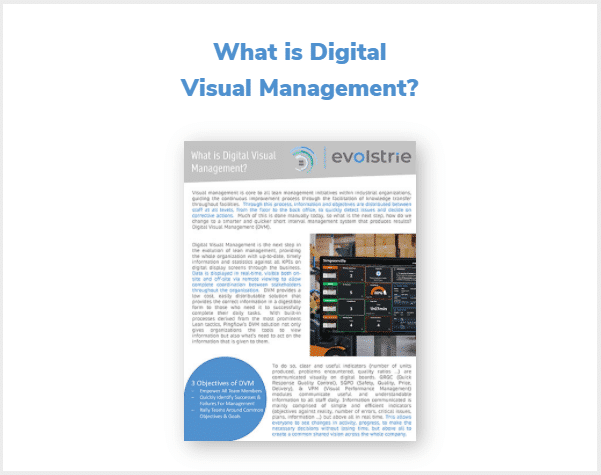Digital Visual Management (DVM) boards tend to gravitate towards a few specific focuses: tracking of progress towards a given goal, the status of current projects, and the communication of issues and ideas. Each board type has unique components and merits.
- Progress Tracking DVM Board – may include charts and trend graphs to visually communicate how the group is performing relative to their defined target. Group or individual KPI’s and action plans are often clearly stated to encourage action. Such boards can be effective in groups that thrive under elements of competition and deadlines.
- Project Status DVM Board – may include allocation of resources and assignment of project teams. These boards often use line charts or timelines to clarify what projects are in which phase of completion and which may need additional attention or support. Groups tracking individual projects or improvement initiatives may find this type beneficial.
- Communication DVM Board – may be more collaborative in nature and have areas for associates to bring issues to the team’s knowledge and alert of impending delays. These boards may include suggestion fields, root cause analysis or problem-solving tools. Such boards can encourage idea generation or create better transparency for current issues.
The use of visual cues can improve a business entity’s communication and thereby its productivity, cost savings, quality, speed, and customer satisfaction. When appropriately implemented and maintained, DVM can quickly convey the status of a process and direct leadership to areas in need of attention. It can convey what is normal, what is abnormal, and what actions and countermeasures have been established to remedy an issue. DVM can be used to effectively address numerous tasks such as goal-setting and performance tracking, scheduling and resource planning, idea sharing and team communication, and the reporting of CIP initiatives’ progress and ultimate results. When used as a routine operational tool, DVM can serve as a direct form of communication between leadership and associates.
However, some business entities often complain that boards become stagnant, outdated, and more of a time and energy hindrance than a positive contribution to the team. The key is to have the board become a part of regular communication and clearly identify what KPIs and goals the team is trying to accomplish. Once the correct goals are identified, the group must decide what visual tools are most appropriate to help in achieving those KPIs.
by Wes Bodenhamer – managing director Evolstrie
Premier Partner of PingFlow in the USA
Download the PDF :




